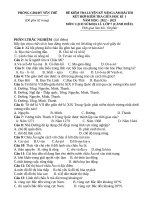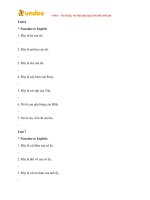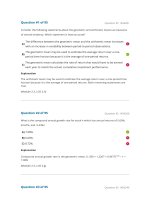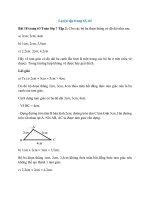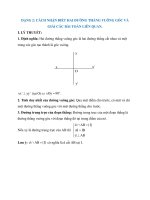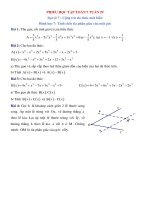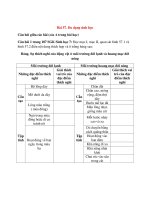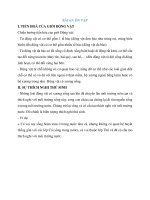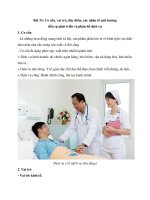27 health liver interpretation and interventions
Bạn đang xem bản rút gọn của tài liệu. Xem và tải ngay bản đầy đủ của tài liệu tại đây (566.62 KB, 11 trang )
UNIVERSITY
Health
Liver Interpretation and
Intervention
Lesson Overview
Functions of the Liver
AAS Impact on Liver
Signs of Liver Dysfunction
Liver Health Intervention Strategies
Liver Functions
• Main site for detoxification of harmful substances in the body. This
can range from alcohol, drugs, hormones (AAS and estrogen),
bilirubin, and ammonia.
• Produces bile to carry away waste products and aid in fat digestion
• Site of carbohydrate metabolism. If blood sugar is to low the liver can
release glucose from stored glycogen to restore normal serum
glucose. The liver can also convert glycerol from fat and amino acids
into glucose via gluconeogenesis.
• The liver is a site of protein metabolism. It produces albumin, a
major transport protein and necessity for oncotic pressure in the
vascular system. It produces many anticoagulant factors as well for
proper blood clotting. Conversion of Ammonia to Urea.
• The liver regulates cholesterol metabolism, by being the site for
lipoprotein production. The liver produces “the good” HDL that help
remove cholesterol from arteries.
• It is a storage site for fat soluble vitamins (A,D,E,K), B12, folate, iron,
and copper.
• Site of conversion of growth hormone to IGF-1
Supraphysiological PED Impact on Liver
Steroid Delivery Method and Toxicity
Oral: 17alpha-alkylated allows protection from 17 beta-HSD in liver
(17aa) steroids associated with liver damage ( cholestatic jaundice,
peliosis, hepatitis, nodular regeneration, hepatic adenoma and
carcinoma.
Hepatotoxicity and transient serum enzyme elevations
AAS increase oxidative liver stress via increase in CTP1
Androgen receptor action increase ROS formation leading to hepatic
mitochondrial degeneration. Degree of AR binding affinity may dictate
hepatotoxicity methandienone vs oxandrolone.
Cholestasis
Most common issue, bile flow decreased via bile duct obstruction.
Increased bile salts and bilirubin in blood. Most common issue. Decreased
appetite, malaise, nausea, upper abdominal pain.
Esterified testosterone derivatives causing liver issues is rare
Case Studies Issues
Solimini et al 2017
Lab evaluation
Lab
Reference Range
Definition
Albumin
3.5-5.5 g/dL
Protein produced in liver,
low levels associated
with poor hepatic
function
globulin
1.5-4.5 g/dL
Protein produced in liver
high levels associated
with liver dysfunction
Total protein
6.0-8.5 g/dL
Total of albumin and
globulin both low and
high can indicate liver
stress
Bilirubin
0.1-1.2 mg/dL
Waste product from
breakdown of RBC
GGT
<50IU/L
Enzyme mainly in
membranes of liver and
most specific for liver
cholestasis.
ALP (alkaline
Phosphatase)
25-150 IU/L
Enzyme mainly in
membranes of liver and
most specific for liver
cholestasis.
AST
0-40 IU/L
Cytosol in liver, shows
hepatic strain but not as
specific as ALT
ALT
0-55 IU.L
Cytosol in liver, shows
hepatic strain
Lab Work Interpretation
AST and ALT are not only found in liver and are in skeletal muscle.
However elevation can sign for acute liver injury
Studies in resistance training find AST and ALT to be elevated for up to
7 days following training and can be 2-3x the normal level.
In theses studies GGT, ALP and bilirubin remain unchanged.
Therefore ensure to limit resistance training prior to lab testing and
include GGT on your liver function test.
Elevated GGT, bilirubin and ALP may indicate cholestasis is present
Liver Detoxification Process
The liver works through a Phase one and Phase two system to detoxify
and eliminate harmful products
Phase one is carried out by the cytochrome P450 enzymes to oxidize,
reduce, and hydrolyze the toxic substance
Phase II then uses conjugation reactions to make the toxins water
soluble to excrete in the urine or feces
When a toxin is processed it can produce free radicals that cause liver
injury and over time this can lead to liver disease.
Each of these systems requires amino acids, vitamins, and antioxidants
to function properly.
Liver Health Interventions
1. Limit toxic load
limit 17aa oral steroids
Limit duration and total dosage of AAS
Select compounds lower AR affinity
Limit AI and SERM use if possible
2. Support Phase 1 and 2 Detoxification enzymes
N-acetyl Cysteine 1200mg per day
Sulforaphane (Broccoli Sprouts)
Milk Thistle Silymarin 500mg
3. Support Bile Acid Flow
Tauroursodeoxycholic acid (TUDCA) 500-1500mg per day
4. Support the Gut-Liver Axis
Increase insoluble and soluble fiber via fruits, veggies, grains
References
Bond P, Llewellyn W, Van Mol P. Anabolic androgenic steroid-induced hepatotoxicity. Med
Hypotheses. 2016 Aug;93:150-3. doi: 10.1016/j.mehy.2016.06.004. Epub 2016 Jun 5. PMID:
27372877.
Schroeder ET, Singh A, Bhasin S, Storer TW, Azen C, Davidson T, Martinez C, Sinha-Hikim I,
Jaque SV, Terk M, Sattler FR. Effects of an oral androgen on muscle and metabolism in older,
community-dwelling men. Am J Physiol Endocrinol Metab. 2003 Jan;284(1):E120-8. doi:
Pettersson J, Hindorf U, Persson P, Bengtsson T, Malmqvist U, Werkström V, Ekelund M.
Muscular exercise can cause highly pathological liver function tests in healthy men. Br J Clin
Pharmacol. 2008 Feb;65(2):253-9. doi: 10.1111/j.1365-2125.2007.03001.x. Epub 2007 Aug
31. PMID: 17764474; PMCID: PMC2291230.
Khoshbaten M, Aliasgarzadeh A, Masnadi K, Tarzamani MK, Farhang S, Babaei H, Kiani J,
Zaare M, Najafipoor F. N-acetylcysteine improves liver function in patients with nonalcoholic Fatty liver disease. Hepat Mon. 2010 Winter;10(1):12-6. Epub 2010 Mar 1. PMID:
22308119; PMCID: PMC3270338.
Cabrera D, Arab JP, Arrese M. UDCA, NorUDCA, and TUDCA in Liver Diseases: A Review of
Their Mechanisms of Action and Clinical Applications. Handb Exp Pharmacol. 2019;256:237264. doi: 10.1007/164_2019_241. PMID: 31236688.
Krawczyk M, Maciejewska D, Ryterska K, et al. Gut Permeability Might be Improved by
Dietary Fiber in Individuals with Nonalcoholic Fatty Liver Disease (NAFLD) Undergoing
Weight Reduction. Nutrients. 2018;10(11):1793. Published 2018 Nov 18.
doi:10.3390/nu10111793
